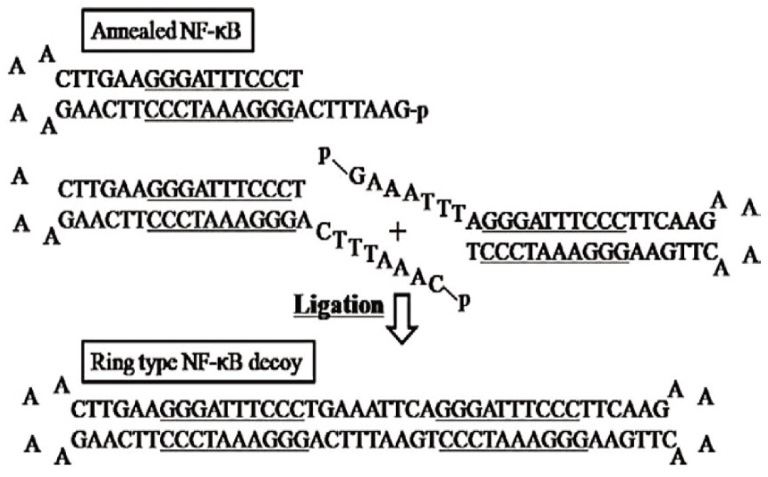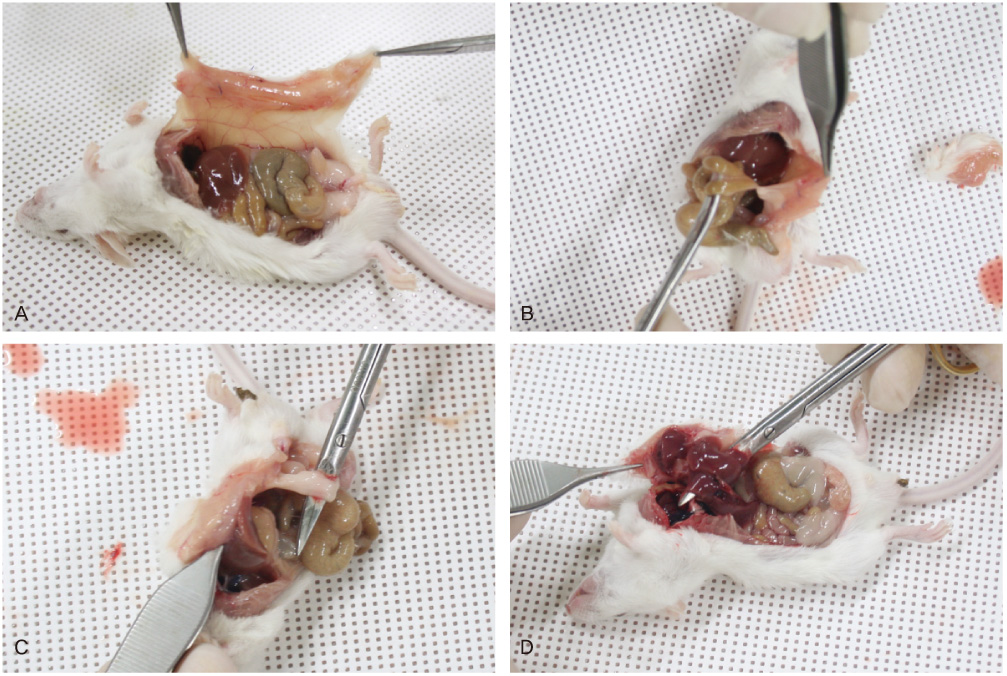Korean J Obstet Gynecol.
2012 Apr;55(4):244-249. 10.5468/KJOG.2012.55.4.244.
Intra-peritoneal NF-kappaB decoy oligodeoxynucleotide decreases postoperative intra-abdominal adhesion
- Affiliations
-
- 1Department of Obstetrics and Gynecology, Catholic University of Daegu School of Medicine, Daegu, Korea. drcys@cu.ac.kr
- 2Department of Pathology, Catholic University of Daegu School of Medicine, Daegu, Korea.
- KMID: 1992620
- DOI: http://doi.org/10.5468/KJOG.2012.55.4.244
Abstract
OBJECTIVE
The objective of this study was to evaluate the effect of intra-peritoneal nuclear factor kappaB (NF-kappaB) decoy oligodeoxynucleotide on the prevention of postoperative intra-abdominal adhesion.
METHODS
Forty female BALB/c mice were randomly assigned into 2 groups. The mice were anesthetized and then midline abdominal incision was made. Peritoneal injury was given using cytobrush until deperitonealization. The experimental group (n = 20) received NF-kappaB decoy oligodeoxynucleotide (NF-kappaB decoy ODN) in the peritoneal cavity before abdominal closure, while the control group (n = 20) received saline. At 2 weeks postoperation, after the mice were euthanized, the status of intra-abdominal adhesion was evaluated. The degrees of adhesion were graded into no (grade 0), mild (grade 1), moderate (grade 2), and severe adhesion (grade 3).
RESULTS
Two mice in the experimental group and 3 mice in the control group were dead within 1 day postoperation. In the control group, 2, 2, and 13 mice showed mild, moderate, and severe adhesion, respectively. In the experimental group, 4 mice showed no adhesion, whereas, 6 and 8 mice showed mild and moderate adhesion, respectively. The difference of degrees of adhesion between the groups was statistically significant (P <0.001).
CONCLUSION
Intra-peritoneal NF-kappaB decoy ODN reduced the severity of postoperative intra-abdominal adhesion.
MeSH Terms
Figure
Reference
-
1. Weibel MA, Majno G. Peritoneal adhesions and their relation to abdominal surgery. A postmortem study. Am J Surg. 1973. 126:345–353.2. Menzies D, Ellis H. Intestinal obstruction from adhesions: how big is the problem? Ann R Coll Surg Engl. 1990. 72:60–63.3. Al-Took S, Platt R, Tulandi T. Adhesion-related small-bowel obstruction after gynecologic operations. Am J Obstet Gynecol. 1999. 180:313–315.4. Al-Jaroudi D, Tulandi T. Adhesion prevention in gynecologic surgery. Obstet Gynecol Surv. 2004. 59:360–367.5. Tulandi T. Effects of fibrin sealant on tubal anastomosis and adhesion formation. Fertil Steril. 1991. 56:136–138.6. Zeng Q, Yu Z, You J, Zhang Q. Efficacy and safety of Seprafilm for preventing postoperative abdominal adhesion: systematic review and meta-analysis. World J Surg. 2007. 31:2125–2131.7. Vrijland WW, Tseng LN, Eijkman HJ, Hop WC, Jakimowicz JJ, Leguit P, et al. Fewer intraperitoneal adhesions with use of hyaluronic acid-carboxymethylcellulose membrane: a randomized clinical trial. Ann Surg. 2002. 235:193–199.8. Kayaoglu HA, Ozkan N, Hazinedaroglu SM, Ersoy OF, Koseoglu RD. An assessment of the effects of two types of bioresorbable barriers to prevent postoperative intra-abdominal adhesions in rats. Surg Today. 2005. 35:946–950.9. Diamond MP. The Sepracoat Adhesion Study Group. Reduction of de novo postsurgical adhesions by intraoperative precoating with Sepracoat (HAL-C) solution: a prospective, randomized, blinded, placebo-controlled multicenter study. Fertil Steril. 1998. 69:1067–1074.10. Friedman H, Stonerock C, Lefaivre J, Yost M. The effect of seprafilm and interceed on capsule formation around silicone discs in a rat model. J Invest Surg. 2004. 17:271–281.11. Keckstein J, Ulrich U, Sasse V, Roth A, Tuttlies F, Karageorgieva E. Reduction of postoperative adhesion formation after laparoscopic ovarian cystectomy. Hum Reprod. 1996. 11:579–582.12. Takeuchi H, Awaji M, Hashimoto M, Nakano Y, Mitsuhashi N, Kuwabara Y. Reduction of adhesions with fibrin glue after laparoscopic excision of large ovarian endometriomas. J Am Assoc Gynecol Laparosc. 1996. 3:575–579.13. Sekiba K. The Obstetrics and Gynecology Adhesion Prevention Committee. Use of Interceed(TC7) absorbable adhesion barrier to reduce postoperative adhesion reformation in infertility and endometriosis surgery. Obstet Gynecol. 1992. 79:518–522.14. Nordic Adhesion Prevention Study Group. The efficacy of Interceed(TC7)* for prevention of reformation of postoperative adhesions on ovaries, fallopian tubes, and fimbriae in microsurgical operations for fertility: a multicenter study. Fertil Steril. 1995. 63:709–714.15. The Myomectomy Adhesion Multicenter Study Group. An expanded polytetrafluoroethylene barrier (Gore-Tex Surgical Membrane) reduces post-myomectomy adhesion formation. Fertil Steril. 1995. 63:491–493.16. Haney AF, Hesla J, Hurst BS, Kettel LM, Murphy AA, Rock JA, et al. Expanded polytetrafluoroethylene (Gore-Tex Surgical Membrane) is superior to oxidized regenerated cellulose (Interceed TC7+) in preventing adhesions. Fertil Steril. 1995. 63:1021–1026.17. Diamond MP. Seprafilm Adhesion Study Group. Reduction of adhesions after uterine myomectomy by Seprafilm membrane (HAL-F): a blinded, prospective, randomized, multicenter clinical study. Fertil Steril. 1996. 66:904–910.18. Duron JJ. Postoperative intraperitoneal adhesion pathophysiology. Colorectal Dis. 2007. 9:Suppl 2. 14–24.19. Guvenal T, Cetin A, Ozdemir H, Yanar O, Kaya T. Prevention of postoperative adhesion formation in rat uterine horn model by nimesulide: a selective COX-2 inhibitor. Hum Reprod. 2001. 16:1732–1735.20. Saed GM, Munkarah AR, Diamond MP. Cyclooxygenase-2 is expressed in human fibroblasts isolated from intraperitoneal adhesions but not from normal peritoneal tissues. Fertil Steril. 2003. 79:1404–1408.21. Binnebösel M, Klink CD, Serno J, Jansen PL, von Trotha KT, Neumann UP, et al. Chronological evaluation of inflammatory mediators during peritoneal adhesion formation using a rat model. Langenbecks Arch Surg. 2011. 396:371–378.22. Kim SJ, Park JH, Kim KH, Lee WR, Lee S, Kwon OC, et al. Effect of NF-kappaB decoy oligodeoxynucleotide on LPS/high-fat diet-induced atherosclerosis in an animal model. Basic Clin Pharmacol Toxicol. 2010. 107:925–930.23. Kim KH, Lee ES, Cha SH, Park JH, Park JS, Chang YC, et al. Transcriptional regulation of NF-kappaB by ring type decoy oligodeoxynucleotide in an animal model of nephropathy. Exp Mol Pathol. 2009. 86:114–120.24. Yoldemir T, Sagol S, Adakan S, Oztekin K, Ozsener S, Karadadas N. Comparison of the reduction of postoperative adhesions by two barriers, one solution, and two pharmacologic agents in the rat uterine model. Fertil Steril. 2002. 78:335–339.25. Jarrett JC 2nd, Dawood MY. Adhesion formation and uterine tube healing in the rabbit: a controlled study of the effect of ibuprofen and flurbiprofen. Am J Obstet Gynecol. 1986. 155:1186–1192.26. Muzii L, Brunetti L, Marana R, Margutti F, Vacca M, Mancuso S. Low-dose aspirin to prevent postoperative adhesion formation in the rabbit model. J Am Assoc Gynecol Laparosc. 1996. 3:S32–S33.27. Muzii L, Marana R, Brunetti L, Margutti F, Vacca M, Mancuso S. Postoperative adhesion prevention with low-dose aspirin: effect through the selective inhibition of thromboxane production. Hum Reprod. 1998. 13:1486–1489.
- Full Text Links
- Actions
-
Cited
- CITED
-
- Close
- Share
- Similar articles
-
- The Effect of Ring-type NF-kappa B(NF-kB) Decoy Oligodeoxynucleotide on the Kidney for an Experimental Unilateral Ureteral Obstruction in Mice
- Clinical Significance of Intra-Abdominal Hypertension
- Effect of Transcription Factor Decoy for NF-κB on the TNF-α Induced Cytokine and ICAM-1 Expression in Cultured HaCaT cells
- Concomitant or Delayed Intra-abdominal Operation in Immediate Breast Reconstruction with TRAM Flap
- Differential Regulation of NF-kappaB Signaling during Human Cytomegalovirus Infection



